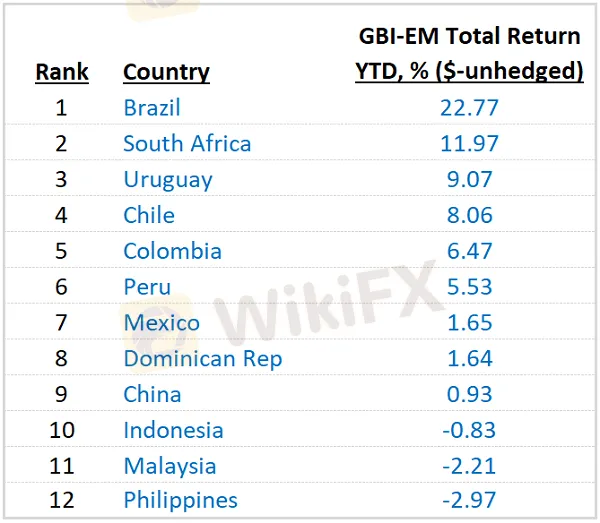简体中文
繁體中文
English
Pусский
日本語
ภาษาไทย
Tiếng Việt
Bahasa Indonesia
Español
हिन्दी
Filippiiniläinen
Français
Deutsch
Português
Türkçe
한국어
العربية
Inflation Front and Center
Abstract:Rising inflation pressures in EM Asia signal that regional central banks might need to tighten sooner than expected. Peru declares a curfew in response to anti-inflation protests.
EM Asia inflation Pressures, Policy Reaction
Upside inflation surprises in several Asian economies caught our attention yesterday evening. The numbers might still look “low” compared to peers in EMEA or LATAM – Thailand‘s prices rose by 5.73% year-on-year, South Korea’s by 4.1% year-on-year, and Philippine by 4% year-on-year. However, when we express headline inflation in standard deviations vs. 5-year history, the picture looks more pressing, especially in South Korea (2.6 standard deviations higher) and Thailand (3.75 standard deviations higher) - these are on par with LATAM! Rising inflation pressures signal that the region might no longer be able to stay on the sidelines (=unchanged policy rates), when the rest of the world is frontloading rate hikes.
LATAM Local Bonds' Outperformance
LATAM has been raising policy rates quite aggressively in the past months, and the improved policy cushion contributed to local bonds‘ year-to-date outperformance. The region outranked all other emerging markets (EM) (with the sole exception of South Africa, see chart below), which is why we are watching the recent changes in central banks’ response functions (smaller than expected rate hikes in Chile and Colombia) with a great deal of interest. This weeks big inflation data dump – Colombia later today, Chile, Mexico, and Brazil later this week – will show whether this relatively dovish policy stance is justified.
Food Prices and Social Protests
In a more concerning development, we are seeing more reports about anti-inflation protests in EM. The Peruvian president was forced to declare a curfew on Tuesday (in the capital) after the protests spread and turned violent. These reports came on the heels of social unrest and the government‘s resignation in Sri Lanka, and the dissolution of Pakistan’s National Assembly. Other vulnerable countries which are highly dependent on wheat exports from Russia and Ukraine – like Tunisia – are working very hard to get supplies from alternative sources (and arrange financing) to avoid the repetition of the Arab Spring. Stay tuned!
Chart at a Glance: LATAM Local Bonds On A Roll

Disclaimer:
The views in this article only represent the author's personal views, and do not constitute investment advice on this platform. This platform does not guarantee the accuracy, completeness and timeliness of the information in the article, and will not be liable for any loss caused by the use of or reliance on the information in the article.
Read more

FED meeting minutes strongly hint at a rate cut in September; US dollar index falls to new low this year!
The U.S. Bureau of Labor Statistics revised down the employment growth in the year ending in March by 818,000, an average monthly decrease of about 68,000, the largest downward revision since 2009. The substantial downward revision of employment data re-emphasized the severity and necessity of the U.S. employment problem, paving the way for a rate hike in September. Bearish for the U.S. dollar.

Gold Price Tops $2500 For the First Time
Gold prices soared above the $2,500 mark for the first time, driven by expectations of potential interest rate cuts, which have weakened the dollar to its recent low levels. Market participants are now focused on Wednesday’s FOMC meeting minutes for insights into the Fed’s next monetary policy moves.

What new signals does the Federal Reserve have? FED Governor Michelle Bowman reiterates the risk of inflation!
Fed Governor Bowman: There are upside risks to inflation, the labor market continues to strengthen, and a cautious attitude will be maintained at the September meeting. Boston Fed President Collins: If the data is as expected, it would be appropriate to start easing policy "soon". Inflationary pressure will slow down the pace of U.S. interest rate cuts, which will be bullish for the dollar.

Europe Analysis: EUR/USD, GBP/USD, EUR/GBP
The ECB's consumer expectations survey shows mixed economic signals with slight improvements in unemployment expectations but unchanged growth forecasts. The euro faces pressure from a strong USD, while the GBP shows resilience, contributing to the strength of GBP/USD and the decline of EUR/GBP.
WikiFX Broker
Latest News
What Makes Cross-Border Payments Easier Than Ever?
Trader Exposes Unethical Practices by STP Trading
Saxo & Portuguese Bank Partnership
SEC Fines Broker-Dealers $275K for Incomplete SAR Filings
Lured by False Promises: Malaysian Driver Lost RM218K to an Investment Scam
FTX Sets March 2025 Timeline for Creditor Payouts: What It Means for Investors
Italian Regulator Warns Against 5 Websites
Mastercard's 2030 Vision: Biometric-Driven, Tokenized Payments
SFC Freezes $91M in Client Accounts Amid Fraud Probe
Bybit Launches Gold & FX Treasure Hunt with Real Gold Rewards
Currency Calculator


